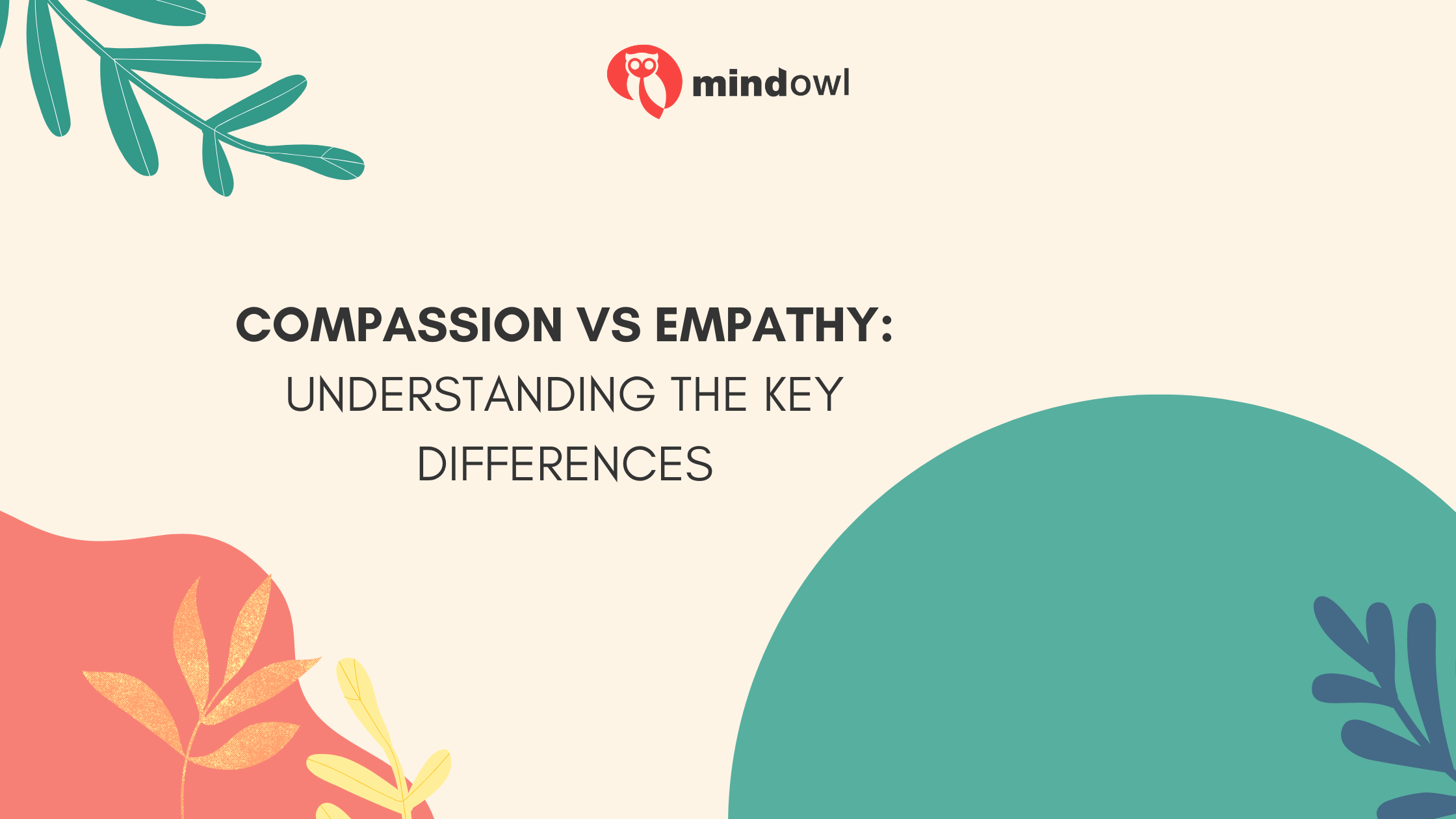Many of us get confused when trying to understand how we relate to the feelings and sufferings of others. This confusion often stems from not knowing the difference between empathy and compassion.
Empathy involves stepping into someone else’s shoes, and feeling what they feel. However, compassion goes a step further—it’s not just about understanding someone’s feelings but also wanting to help alleviate their distress.
One vital fact is that while empathy focuses on sharing emotions, compassion pushes us towards taking action to support or aid those in need. Our article aims to clear up any confusion you might have about these two concepts.
We’ll explore what sets them apart and why both are crucial in creating meaningful connections with those around us. Ready for some clarity? Keep reading!
Key Takeaways
- Empathy means understanding and sharing someone else’s feelings, like feeling sad because your friend is sad.
- Compassion goes beyond empathy by not only understanding someone’s pain but also wanting to help ease it.
- While empathy involves feeling the same emotions as another person, compassion includes taking action to make a positive difference in their lives.
- Being empathetic can help us connect with others on an emotional level; however, showing compassion brings about change through acts of kindness or support.
- To become more compassionate and empathetic, practice active listening, cultivate mindfulness, and seek to understand people’s perspectives without judgment.

Definition and Examples of Empathy
Empathy is about feeling what someone else feels. This ability lets us understand and share in another person’s emotions. It plays a big part in how we connect with others. Imagine a friend is going through a tough time because they lost their pet.
If you’ve ever lost something special, you can recall that sadness and relate to what your friend feels without them having to explain much.
We see examples of empathy in our day-to-day lives, like when someone picks up on our mood without us saying anything. Teachers who notice students feeling down and offer extra help are showing empathy too.
It’s this emotional understanding that makes people want to reach out and help each other, making it an essential building block of good relationships and kindness towards others.
Definition and Examples of Compassion
Compassion is a profound human emotion that connects us to others who are suffering. At its core, compassion involves feeling a deep sense of empathy and concern for another’s pain or difficulties, coupled with a strong motivation to help alleviate that suffering in some way.
True compassion goes beyond just an intellectual understanding or superficial acknowledgement of someone else’s struggles. It requires us to emotionally resonate with their experience, to metaphorically walk a mile in their shoes and feel what they are feeling. Only then can we be fully present and attuned to their needs at that moment.
Acts of compassion can take many forms, both large and small. It may involve simply listening without judgment as someone shares the weight of their troubles. It could mean providing physical care and assistance to someone who is ill or disabled. Or it could translate into more overt actions like volunteering time, giving financial or material resources, or using our skills and influence to advocate for those whose voices are not being heard.
The Differences Between Empathy and Compassion
Empathy involves understanding and sharing someone else’s feelings, while compassion is more about feeling concern for others’ suffering. Empathy focuses inwardly on recognising emotions, whereas compassion has an outward focus on taking action to help others.
Emotional Connection Vs Deep Understanding
Empathy allows someone to feel what another person is going through. It’s like standing in their shoes, feeling their joy or pain. Compassion goes a step further. It adds the desire to help ease that pain or enhance that joy.
This shows the difference between merely connecting emotionally and understanding deeply enough to act.
Feeling empathy is just the start; showing compassion brings it full circle. Empathy involves sharing emotions, while compassion includes actions driven by those feelings. A person may empathise with someone else’s struggle but acting on it—offering support, kindness, or help—is compassion at work.
Feeling Vs Recognising
Empathy means you share someone’s feelings. You feel sad if they’re sad. Compassion is different. It means seeing someone’s pain and wanting to help them feel better.
Imagine seeing a friend fall off their bike. If you’re empathetic, you might wince because you can imagine how much it hurts. But with compassion, you think about ways to make your friend feel better, like getting them a plaster or helping them up.
Being compassionate needs us to recognise another person’s trouble and then take steps to improve their situation. It goes beyond feeling their sorrow from the sidelines; it involves an active desire to alleviate that suffering through kind acts or supportive words.
Inward Vs Outward Focus
Understanding another person’s feelings is at the heart of empathy. You feel what they feel, right inside yourself. This inward focus makes empathy a personal, internal experience.
It’s like putting on someone else’s shoes and walking in them. Your thoughts revolve around how you connect with those emotions within your own self.
Compassion takes this a step further by pushing us to act. Here, the focus shifts outwardly. Seeing someone in trouble doesn’t just make you feel their pain; it moves you to help them out of their situation.
Whether it’s through kind words or acts of kindness, compassion involves doing something that has an immediate impact on others’ well-being.
Emotion Vs Action
Empathy and emotional connection are important but don’t always lead to action. On the other hand, compassion drives us to help. It goes beyond understanding feelings to taking steps that make a difference in people’s lives.
Feeling empathy can happen from a distance, with no real change in the situation. Compassion, however, pulls us closer and compels us to act—whether through kind words or supportive actions.
It means not just sharing in someone’s suffering but also working to ease it. While empathy touches hearts, compassion moves hands and feet towards positive change.

The Importance of Both Empathy and Compassion
Through empathy, we can build deeper interpersonal bonds, communicate more effectively, and cooperate with greater ease. It allows us to see from diverse perspectives, reducing prejudices and fostering more inclusive communities. Empathy is a cornerstone of emotional intelligence – that crucial capacity for attuning to the feelings underlying human behaviour and relationships.
Yet empathy alone is incomplete without its partner, compassion. Compassion takes the resonance cultivated through empathy and translates it into an authentic desire to help, to alleviate another’s suffering, to actively work towards improving their situation in some way. If empathy allows us to feel the raindrop’s journey, compassion is the force that compels us to offer an umbrella.
Compassion instills a sense of moral courage – the strength to stand up against cruelty, and injustice, and defend those whose voices are marginalized. It inspires helping behaviours, motivating people to extend themselves through generosity of spirit, resources, effort or influence. On a societal level, compassion weaves a web of care and concern that strengthens the bonds of the greater human community.
Exploring the Pros and Cons of Empathy and Compassion
Exploring the pros and cons of empathy and compassion gives us insight into how these qualities impact personal and professional relationships. Let’s dive into a detailed comparison.
| Quality | Pros | Cons |
|---|---|---|
| Empathy |
|
|
| Compassion |
|
|
How to Become More Compassionate and Empathetic
Practice Active Listening
Practice active listening by giving the speaker your full attention. Shut out distractions and focus on their words. Engage with what they’re saying through eye contact and verbal affirmations, like nodding or small verbal cues.
Avoid interrupting or imposing your own thoughts, instead, show empathy through understanding and acknowledgement of their emotions. This will foster a sense of trust and create a safe space for open communication.
Use open-ended questions to encourage the speaker to share more about their experiences. Reflect on what they’ve said to show that you understand them. This can help deepen emotional connections and demonstrate genuine compassion towards others’ feelings and experiences.
Cultivate Mindfulness
Incorporating mindfulness practices into your daily routine can gradually nurture a more mindful mindset, leading to increased empathy and compassion towards others while reducing stress and anxiety.
Mindful breathing techniques can help to increase awareness of the present moment and promote a sense of calm. Another way to cultivate mindfulness is through regular meditation sessions – these assist in training the mind to focus and stay present. Additionally, engaging in mindful activities such as walking or journaling can further enhance mindfulness levels.
Mindfulness promotes emotional intelligence and fosters a better understanding of one’s own emotions and those of others. Regular mindfulness exercises are associated with increased self-compassion, allowing individuals to respond with kindness rather than judgment towards themselves and others.
Seek to Understand
When trying to understand others, listen actively and show genuine interest in their perspective. Try to see things from their point of view and acknowledge their feelings without judgment.
Understanding someone else’s experiences can strengthen your empathy and compassion, enhancing your ability to connect with them on a deeper level.
By engaging in open and non-judgemental conversations, you can gain valuable insights into the emotions and struggles of others. This allows you to recognise the significance of their experiences and respond with empathy and kindness.
Conclusion
In conclusion, understanding the differences between empathy and compassion is crucial. Each involves a unique approach to relating to others’ emotions and offering support. Both are essential for fostering kindness, understanding, and meaningful connections with others.
By recognising their distinctions and importance, we can actively cultivate these qualities in our interactions with the people around us.
FAQs
1. What’s the main difference between compassion and empathy?
Empathy is about feeling what someone else is feeling; it’s like putting yourself in their shoes. Compassion, on the other hand, goes a step further—it’s not just understanding or sharing others’ emotions but also having a strong desire to help ease their suffering.
2. Can you feel empathy without compassion?
Yes, indeed! You can understand and share another person’s emotional state—this is called empathy—but that doesn’t automatically mean you’ll feel compelled to help them. That action-oriented part? That’s where compassion kicks in.
3. Are there different types of empathy?
There are mainly two types: cognitive and emotional empathy. Cognitive lets you understand another person’s perspective or mental state, while emotional means you literally feel what they’re going through as if it were happening to you.
4. Why do some people seem more compassionate than others?
It often comes down to how we’re wired and our life experiences—some might naturally have high empathy levels, making it easier for them to be compassionate. Plus, things like compassion training can really boost your ability to empathise with others and take action.
5. How does practising compassion benefit me?
Practising compassion isn’t just good for others; it’s great for you too! It can lead to stronger connections with people around you because seeing someone genuinely cares makes relationships deeper and more meaningful.
6. Is being too empathetic a bad thing?
Interesting point—while being empathetic shows that you understand and connect with what someone else is experiencing, very high levels of empathy could make one absorb too much of other people’s negative emotions. However, learning how to manage these feelings can turn high empathy into a powerful tool for positive change.
MindOwl Founder – My own struggles in life have led me to this path of understanding the human condition. I graduated with a bachelor’s degree in philosophy before completing a master’s degree in psychology at Regent’s University London. I then completed a postgraduate diploma in philosophical counselling before being trained in ACT (Acceptance and commitment therapy).
I’ve spent the last eight years studying the encounter of meditative practices with modern psychology.

